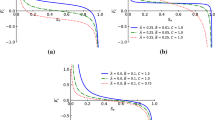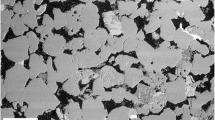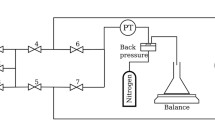Abstract
A simple capillary model of free spontaneous imbibition and waterflood is introduced and used to interpret the ‘complete’ capillary number CA for immiscible displacement in porous media. The ‘complete’ capillary number is applied to characterize saturation profile histories obtained in sandpacks. Its value is equal to 1 in free spontaneous imbibition, and in a waterflood it is equal to the ratio of the water injection rate to the initial rate of free spontaneous imbibition. In situ saturation profiles in waterfloods in sandpacks at 1:1 viscosity ratio were determined by light transmission measurement. For CA ≪ 1 capillary forces controlled and the saturation rose practically uniformly along the entire length of the model from the initial connate water saturation to the final value, corresponding to residual oil saturation. For CA ≫ 1 viscous forces controlled and there was a step change in saturation from the connate water to the residual oil value, advancing as a piston. At intermediate values of CA the saturation profiles were S-shaped curves. The saturation profile histories in two packs of different lengths of the same sand were identical, within experimental error, at the same values of CA in the two packs, if plotted against normalized distance coordinates. The saturation profile histories measured in packs of the same length of two very different sands A and B were found to be similar for values of CA in the ratio (CA)B/(CA)A ≈ 5, for all values of CA.
Similar content being viewed by others
References
Bacri, J. C., Leygnac, C. and Salin, D.: 1985, Evidence of capillary hyperdiffusion in two-phase fluid flows, J. Phys. (Paris) Lett. 46(11), L467–473.
Bacri, J. C., Rosen, M. and Salin, D.: 1990, Capillary hyperdiffusion as a test of wettability, Europhys. Lett. II(2), 127–132.
Buckley, S. E. and Leverett, M. C.: 1942, Mechanism of fluid displacement in sands, Trans., AIME 146, 107–116.
Douglas, J. Jr., Blair, P. M. and Wagner, R. J.: 1958, Calculation of linear waterflood behaviour including the effects of capillary pressure, Trans., AIME 213, 96–102.
Douglas, J. Jr., Peaceman, D. W. and Rachford, H. H. Jr.: 1959, A method for calculating multidimensional immiscible displacement, Trans., AIME 216, 297–308.
Dullien, F. A. L.: 1988, Two-phase flow in porus media, Chemical Engineering and Technology 11, 407.
Dullien, F. A. L.: 1992, Porous media: Fluid transport and pore structure, 2nd edn, Academic Press, San Diego.
Fayers, F. J. and Sheldon, J. W.: 1959, The effect of capillary pressure and gravity on two-phase fluid flow in a porous medium, Trans., AIME 216, 147–155.
Fokas, A. S. and Yortsos, Y. C.: 1982, On the exactly solvable equation S t = [(βS + γ)−2 S x]x + α(βS + γ)−2 S x occurring in two-phase flow in porous media, SIAM J. Appl. Math. 42(2), 318–332.
Kueper, B. H. and Frind, E. O.: 1991, Two-phase flow in heterogeneous porous media 1. Model development, Water Resources Research 27(6), 1049–1057.
Leverett, M. C.: 1941, Capillary behaviour in porous solids, Trans., AIME 142, 152–169.
McWhorter, D. B.: 1971, Infiltration affected by flow of air, Hydrol. Pap. No. 49, Colorado State Univ. May.
McWhorter, D. B. and Sunada, D. K.: 1990, Exact integral solution for two-phase flow, Water Resources Research 26(3), 399–413.
Dong, M., and Dullien, F. A. L.: 1997, A new model for immiscible displacement in porous media, Transport in Porous media, in press.
Morel-Seytoux, H. J.: 1973, Two-phase flow in porous media, In: R. J. M. DeWiest (ed.), Advances in Hydroscience, Vol. 9, Academic Press, San Diego.
Porcelli, P. C. and Bidner, M. S.: 1994, Simulation and transport phenomena of a ternary two-phase flow, Transport in Porous media 14(2), 101–122.
Rapoport, L. A. and Leas, W. J.: 1953, Properties of linear waterfloods, Trans., AIME 198, 139.
Taber, J. J.: 1981, Research on enhanced oil recovery: past, present and future, from Surface phenomena in enhanced oil recovery (D. O. Shah ed.), Plenum Press, New York, pp.13–52.
Yortsos, Y. C. and Fokas, A. S.: 1983, An analytical solution for linear waterflood including the effects of capillary pressure, Soc. Pet. Eng. J. 23(1), 115–124.
Author information
Authors and Affiliations
Rights and permissions
About this article
Cite this article
Dong, M., Dullien, F.a.L. & Zhou, J. Characterization of Waterflood Saturation Profile Histories by the ‘Complete’ Capillary Number. Transport in Porous Media 31, 213–237 (1998). https://doi.org/10.1023/A:1006565621860
Issue Date:
DOI: https://doi.org/10.1023/A:1006565621860




